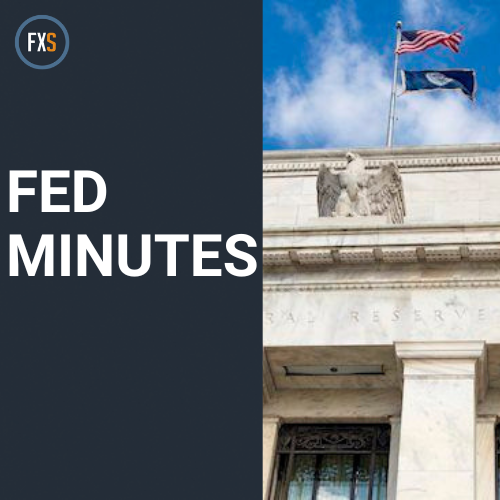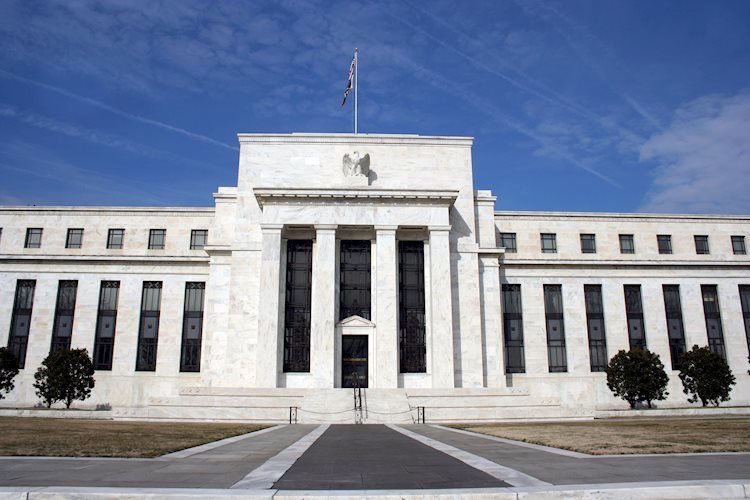Jerome Powell and co’s discussions surrounding the inflation outlook will be scrutinized.
Markets see a less than 40% probability that the Fed will leave the policy rate unchanged in September.
The Federal Reserve (Fed) will release the minutes of the April 30-May 1 policy meeting on Wednesday at 18:00 GMT. Investors will pay close attention to comments regarding the inflation outlook and the possible timing of a policy pivot.
The Fed left unchanged its monetary policy settings following the April 30-May 1 policy meeting as expected. In its policy statement, the US central bank said that there has recently been a lack of further progress toward the 2% inflation target. Regarding the quantitative tightening strategy, the Fed noted that they will slow the decline of the balance sheet by cutting the Treasury redemption cap to $25 billion per month from $60 billion starting June 1.
In the post-meeting press conference, Fed Chairman Jerome Powell noted that it was unlikely that the next policy move would be another rate hike but explained that it could be appropriate to hold off on interest rate cuts if inflation proves more persistent and labor market remains strong. Powell reiterated that they need to have greater confidence in inflation moving toward 2% before considering a policy pivot.
The data published by the US Bureau of Labor Statistics showed on May 15 that the core Consumer Price Index (CPI) rose 3.6% on a yearly basis in April. This reading followed the 3.8% increase recorded in March and came in line with the market expectation. On a monthly basis, the CPI and the core CPI both rose 0.3% after rising 0.4% in March.
According to the CME FedWatch Tool, markets see little to no chance of a Fed rate cut either in June or July. The probability of the Fed holding the policy rate in September, however, stays about 37%.
Previewing the Fed’s publication, “the minutes from the most recent FOMC meeting are likely to grab attention next week following the Committee’s decision to communicate that “higher for longer” remains the policy of choice in the near horizon,” TD Securities analysts said and added: “Further color regarding the decision to taper QT will also be in focus.”
The Fed will release the minutes of the April 30-May 1 policy meeting at 18:00 GMT on Wednesday. Investors will pay close attention to discussions surrounding the inflation outlook and look for possible hints on the timing of the policy pivot.
Following the release of the April inflation report, several Fed policymakers adopted a cautious language regarding the rate outlook while recognizing the modest progress in disinflation. San Francisco Fed President Mary Daly noted on Monday that, while she expects shelter inflation to improve slowly, as she said that she doesn’t expect progress to be quick. Daly also noted that she is not confident that inflation is sustainably coming down to the Fed’s 2% inflation target. Additionally, Fed Vice Chair for Supervision Michael Barr argued that the Fed is in a good position to hold the policy steady and watch the economy.
In case the minutes show that policymakers lean toward taking a patient approach to policy easing in the face of strong inflation and favor a single rate cut later in the year, the US Dollar (USD) could hold its ground against its major rivals. If the publication suggests that officials are increasingly concerned about the growing signs of a slowdown in economic activity and remain optimistic about the inflation outlook, risk flows could dominate the markets and hurt the USD.
Eren Sengezer, European Session Lead Analyst, shares a brief technical outlook for the USD Index:
“The USD Index (DXY) stays dangerously close to the 104.30-104.20 area, where the 200-day and the 100-day Simple Moving Averages (SMA) are located. In case the index falls below this area and starts using it as resistance, technical sellers could take action. In this scenario, 103.70 (Fibonacci 50% retracement of the January-April uptrend) could act as interim support before 103.00 (Fibonacci 61.8% retracement). On the upside, resistances could be seen at 105.25 (Fibonacci 23.6% retracement, 20-day SMA), 106.00 (static level, psychological level) and 106.50 (endpoint of the uptrend).”
Economic Indicator
FOMC Minutes
FOMC stands for The Federal Open Market Committee that organizes 8 meetings in a year and reviews economic and financial conditions, determines the appropriate stance of monetary policy and assesses the risks to its long-run goals of price stability and sustainable economic growth. FOMC Minutes are released by the Board of Governors of the Federal Reserve and are a clear guide to the future US interest rate policy.
Last release: Wed Apr 10, 2024 18:00
Frequency: Irregular
Actual: –
Consensus: –
Previous: –
Source: Federal Reserve
Minutes of the Federal Open Market Committee (FOMC) is usually published three weeks after the day of the policy decision. Investors look for clues regarding the policy outlook in this publication alongside the vote split. A bullish tone is likely to provide a boost to the greenback while a dovish stance is seen as USD-negative. It needs to be noted that the market reaction to FOMC Minutes could be delayed as news outlets don’t have access to the publication before the release, unlike the FOMC’s Policy Statement.
US Dollar FAQs
The US Dollar (USD) is the official currency of the United States of America, and the ‘de facto’ currency of a significant number of other countries where it is found in circulation alongside local notes. It is the most heavily traded currency in the world, accounting for over 88% of all global foreign exchange turnover, or an average of $6.6 trillion in transactions per day, according to data from 2022. Following the second world war, the USD took over from the British Pound as the world’s reserve currency. For most of its history, the US Dollar was backed by Gold, until the Bretton Woods Agreement in 1971 when the Gold Standard went away.
The most important single factor impacting on the value of the US Dollar is monetary policy, which is shaped by the Federal Reserve (Fed). The Fed has two mandates: to achieve price stability (control inflation) and foster full employment. Its primary tool to achieve these two goals is by adjusting interest rates. When prices are rising too quickly and inflation is above the Fed’s 2% target, the Fed will raise rates, which helps the USD value. When inflation falls below 2% or the Unemployment Rate is too high, the Fed may lower interest rates, which weighs on the Greenback.
In extreme situations, the Federal Reserve can also print more Dollars and enact quantitative easing (QE). QE is the process by which the Fed substantially increases the flow of credit in a stuck financial system. It is a non-standard policy measure used when credit has dried up because banks will not lend to each other (out of the fear of counterparty default). It is a last resort when simply lowering interest rates is unlikely to achieve the necessary result. It was the Fed’s weapon of choice to combat the credit crunch that occurred during the Great Financial Crisis in 2008. It involves the Fed printing more Dollars and using them to buy US government bonds predominantly from financial institutions. QE usually leads to a weaker US Dollar.
Quantitative tightening (QT) is the reverse process whereby the Federal Reserve stops buying bonds from financial institutions and does not reinvest the principal from the bonds it holds maturing in new purchases. It is usually positive for the US Dollar.
Share:
Feed news
Information on these pages contains forward-looking statements that involve risks and uncertainties. Markets and instruments profiled on this page are for informational purposes only and should not in any way come across as a recommendation to buy or sell in these assets. You should do your own thorough research before making any investment decisions. FXStreet does not in any way guarantee that this information is free from mistakes, errors, or material misstatements. It also does not guarantee that this information is of a timely nature. Investing in Open Markets involves a great deal of risk, including the loss of all or a portion of your investment, as well as emotional distress. All risks, losses and costs associated with investing, including total loss of principal, are your responsibility. The views and opinions expressed in this article are those of the authors and do not necessarily reflect the official policy or position of FXStreet nor its advertisers. The author will not be held responsible for information that is found at the end of links posted on this page.
If not otherwise explicitly mentioned in the body of the article, at the time of writing, the author has no position in any stock mentioned in this article and no business relationship with any company mentioned. The author has not received compensation for writing this article, other than from FXStreet.
FXStreet and the author do not provide personalized recommendations. The author makes no representations as to the accuracy, completeness, or suitability of this information. FXStreet and the author will not be liable for any errors, omissions or any losses, injuries or damages arising from this information and its display or use. Errors and omissions excepted.
The author and FXStreet are not registered investment advisors and nothing in this article is intended to be investment advice.





